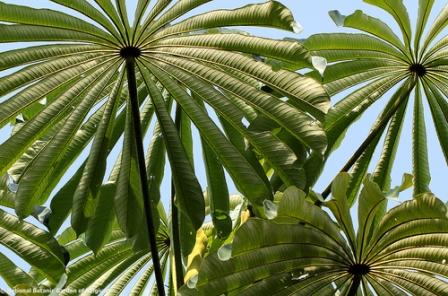Musanga cecropioides

|
|
Musanga cecropioides Common Names: African Corkwood, Umbrella Tree,
Parasolier Scientific
Classification Kingdom: Plantae Clade: Tracheophytes Clade: Angiosperms Order: Rosales Family: Urticaceae Genus: Musanga Species: M. cecropioides Authority: R.Br. ex Tedlie Synonyms: Musanga smithii R. Br., Musanga leo-errerae Hauman & J.Léonard Morphological Description Musanga cecropioides is a fast-growing, evergreen, dioecious tree in the
Urticaceae family, reaching heights of 18–45 m with an umbrella-shaped crown: · Bole: Straight, cylindrical, 50–100 cm in diameter, pale whitish
to yellow, rough with granular texture; supported by stilt roots 2–3 m tall
(Burkill, 1985). · Leaves: Large, palmately compound, 30–60 cm across, with 7–11
leaflets, ovate, 10–20 cm long, glossy green (Berg & Hijman, 1989). · Inflorescence: Axillary, enclosed in wine-red stipular sheaths, unisexual,
with small yellowish flowers (Burkill, 1985). · Fruit: Compound, fleshy, edible, orange when ripe, 2–3 cm wide,
borne in clusters (Fern, 2024). Distribution and Habitat Musanga cecropioides is a pioneer species native to tropical Africa: · Range: Sierra Leone to Angola, east to Uganda and DR Congo;
introduced in Madagascar (Berg & Hijman, 1989). · Habitat: Wet tropical rainforests, secondary forests, disturbed areas
(e.g., old farms, fallows); thrives at 0–1,500 m elevation, rainfall
1,500–3,000 mm/year, well-drained soils (Fern, 2024). Ethnopharmacology Musanga cecropioides is widely used in African traditional medicine, with
phytochemicals like saponins, flavonoids, and tannins (Adeneye et al., 2006),It
is widely used in traditional African medicine for its diverse therapeutic
properties. The bark, leaves, roots, and latex are employed to treat various
ailments due to the plant’s anti-inflammatory, analgesic, antimicrobial,
antioxidant, and antidiabetic properties. Traditional uses include the
treatment of rheumatism, fevers, wounds, ulcers, toothaches, and respiratory
conditions such as asthma and coughs. The stem bark and root decoctions are
also used for malaria, gastrointestinal disorders, and as a liver tonic.
Phytochemical analyses have revealed compounds such as flavonoids, alkaloids,
saponins, and tannins, which are believed to underlie its medicinal effects.
Though traditionally well-regarded, further pharmacological studies are
necessary to scientifically validate its efficacy and determine safe dosages
for therapeutic use. · Galactagogue: Bark sap with maize pap in Nigeria boosts lactation. Burkill
(1985) notes its traditional use among Yoruba women. · Antibacterial/Antifungal: Root sap in Cameroon fights infections.
Uwah et al. (2013) found sap extracts (MIC 25 µg/mL) active against Escherichia coli. · Hypotensive: Bark decoctions in Ghana lower blood pressure. Dongmo et al.
(2002) showed leaf extract (35 mg/mL) reduced rat blood pressure by 20%. · Antidiabetic: Stem bark in Nigeria manages diabetes. Adeneye et al. (2007)
reported 500 mg/kg extract lowered glucose in diabetic rats by 35%. · Anti-inflammatory/Analgesic: Leaves in Osun, Nigeria, treat rheumatism.
Sowemimo et al. (2015) found 150 mg/kg leaf extract inhibited edema in rats by
71%. ⚠ Toxicity Profile: High doses of stem bark extract (>3,000
mg/kg) caused transient sedation and reduced locomotion in rats. Sap may
irritate skin due to phenolic compounds. Avoid in pregnancy due to oxytocic
effects (Adeneye et al., 2006; Ayinde et al., 2006). Additional Uses · Timber: Lightweight wood (density 0.3 g/cm³) for rafts, toys,
crates; hollowed boles for canoes (Fern, 2024). · Water Source: Stilt roots and stems yield potable water in dry seasons
(Burkill, 1985). · Culinary: Wood ash as vegetable salt; fruit flesh edible but rarely
consumed (Berg & Hijman, 1989). · Ecological: Pioneer species aiding forest regeneration; shade tree in
coffee plantations (Fern, 2024). References
External Links More Pictures |
|
| Compounds of Musanga cecropioides | |
| References |